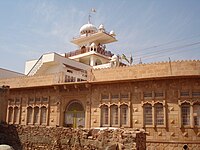Veer Teja
Veer Teja or Tejaji is a Rajasthani folk deity. He is considered one of the major eleven incarnations of Shiva and worshipped as a deity in whole (Rural & Urban) Rajasthan.[1][2]
| Veer Teja | |
|---|---|
Hindu | |
 Tejaji riding a horse | |
| Affiliation | Deva, Avatar of Shiva |
| Personal information | |
| Born | 1074 |
| Died | 1103 |
| Parents |
|
Veer Teja was born around 1074 in Khadnal, Rajasthan, India. His parents, Ramkunwari and Tahar, were Jat.[3][4][5][6][7]
Legend has it that Teja died in 1103. The story says that he died because of snake bite, he allowed a snake to bite his tongue, that being the only unwounded area of his body. In return, the snake promised that no person or animal would die from a snakebite if they sought the blessings of Teja.[7]
People in Rajasthan particularly call upon this promise on Shukla tenth of the month of Bhadrapada, a day that is set aside for marking his death.[7]
Anthropologists say the Tejaji following sect is protagonist that includes an element of protest against the caste system.[8]
Painting depicting Tejaji's marriage at Pushkar


See also[]
- Tejaji Temple at Kharnal - place where Tejaji was born
- Tejaji temple at Paner - place where Tejaji was married
- Shree Veer Tejaji samadhi sthala Temple, Sursura - place where Tejaji attained Nirvana
Commemoration[]
In September 2011, India Post released a commemorative stamp depicting Tejaji.[9]
A Rajasthani language movie titled Veer Tejaji, based on the life of Tejaji was made in the 1980s.
References[]
- ^ Reuters Editorial. "In India, getting bitten by a snake seen as good luck". U.S. Retrieved 16 October 2018.
- ^ ANI (16 September 2016). "Rajasthan celebrates unique snake festival to bring good fortune". India.com. Retrieved 16 October 2018.
- ^ Jain, Pratibha; Śarmā, Saṅgītā (2004). Honour, Status & Polity. Rawat Publications. p. 336. ISBN 978-8-170-33859-8. Retrieved 1 July 2021.
- ^ Aryan, Subhashini (1994). Folk Bronzes of Rajasthan. Lalit Kala Akademi. p. 80. Retrieved 1 July 2021.
- ^ (Agency), Rajputana (1879). The Rajputana Gazetteer, Volume 2. Office of the Superintendent of Government Print. Retrieved 1 October 2021.
- ^ (India), Rajasthan (1970). Rajasthan [district Gazetteers].: Tonk. Printed at Government Central Press. Retrieved 1 October 2021.
- ^ a b c Hooja, Rima (2006). A History of Rajasthan. Rupa Publications. p. 428. ISBN 978-8129108906. Retrieved 16 February 2019.
- ^ Dhali, Rajshree Popular Religion in Rajasthan: A Study of Four Deities and Their Worship in Nineteenth and Twentieth Century, 2014, p. 229
- ^ Rajasthan Voice: Thursday, September 8, 2011, Special postage stamp released on Folk deity Veer Teja
Further reading[]
- Madan Meena: Tejaji Gatha (Hadoti & Hindi), Kota Heritage Society, Kota, 2012 ISBN 978-81-8465-686-2 (Published under the World Oral Literature Project, University of Cambridge, UK)
- Folk deities of Rajasthan
- Hindu folk deities
- 1304 deaths
- 1250s births


